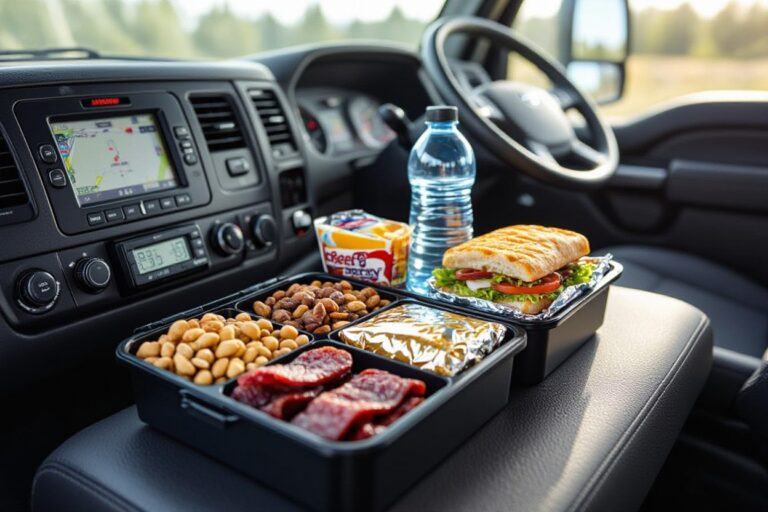
This quick checklist helps you instantly decide if a load is worth hauling: verify equipment fit, weight, route restrictions, and pay; watch for hidden fees or safety risks like overweight, permits, or unsecured cargo that can cost you, and favor loads with clear, high pay and a reliable broker to protect your time and earnings. Use your experience to spot red flags fast.

Key Takeaways:
- Quickly compute net CPM: subtract fuel, tolls, and expected deadhead from the offered rate to see true pay per mile.
- Scan load details for route alignment, weight/permit needs, and likely detention/accessorials that can make or break profitability.
- Confirm broker/carrier payment terms and reputation—a reliable payer often outweighs a slightly higher but risky rate.

The Real Cost of Hauling: Beyond Price Tags
Direct Costs: Fuel and Maintenance
Your truck at 6 mpg for a 500‑mile run uses ~83 gallons; at $4/gal that’s about $332 in fuel alone, and routine maintenance typically adds $0.12–$0.18 per mile (another $60–$90). Tires cost $400–$600 each and a brake or injector job can cost thousands, so the sticker rate can be wiped out by one unexpected repair or fuel spike.
Indirect Costs: Time and Opportunity
Four to eight hours of detention, a 200‑mile deadhead, or hitting your 11‑hour drive limit can prevent you from taking a backhaul; that missed opportunity often equals $400–$1,000 of foregone revenue. ELDs and the 14‑hour duty window mean time lost is revenue lost, not just idle minutes.
Example: you accept a $1,200 load with a 200‑mile deadhead and suffer 10 hours detention, which blocks a nearby $700 backhaul; after $332 fuel, $80 maintenance and the missed $700, your net drops dramatically — the true profit can fall by 40–60% versus the advertised payout.
Decoding Load Descriptions: What Drivers Overlook
Spot vague weights like “approx 40,000 lb” or pallet counts listed as “10-12” — they hide risk you have to price. Check the freight class/NMFC; a 53′ dry van typically carries ~45,000 lb payload, while exceeding 80,000 lb GVW forces overweight permits and fines. Watch for “reweigh” clauses, hazmat notes, liftgate/tarp requirements and accessorials that will erode your margin; low value per pound combined with extra stops becomes dangerous.
Analyzing Weight vs. Value
Crunch the math: divide the linehaul by the manifested weight to get $/lb or convert to $/cwt. If you take $2,000 on 40,000 lb, that’s $0.05/lb or $5/cwt. Loads under about $0.04/lb (or <$4/cwt) usually signal thin margins once fuel, detentions and reweighs hit. Factor in pallet density and cubic constraints — heavy, low-value freight like sand or scrap often fails this test even if weight looks attractive.
Evaluating Distance: Short Haul vs. Long Haul
Short hauls pile up deadhead, hookups and idling, so if you run a 100-mile load with 20 miles deadhead and an hour wait your effective rate can drop 20–40%. Use fuel math: at 6 mpg and $4/gal fuel equals ~$0.67/mi. Long hauls pay steadier $/mile but you face HOS limits, cross‑border permits and more layover risk that eats hours and pay.
Do an effective-rate calc: divide the rate by (loaded miles + deadhead miles), then subtract variable costs to see what you actually make. Example: $1,200 for 200 loaded miles plus 50 deadhead = $4.80/mi gross. Subtract fuel (~$0.67/mi at 6 mpg, $4/gal) and driver pay (e.g., $25/hr × 6 hrs = $150 → $0.60/mi) and you end up near $3.53/mi net before tolls, permits and equipment wear — decide if that covers your fixed costs.
The Art of Negotiation: Getting the Best Rate
Use lane comps from DAT or Truckstop and run a quick margin calc: a 500‑mile haul at $1.75/mile yields $875; subtract ~30% operating costs and you’re at $612.50. Add fuel, tolls, permits and expected deadhead to reveal true profit. Ask for accessorials—detention, layover, reconsignment—and present counteroffers tied to those line‑item costs so you’re not negotiating blind.
When to Stand Firm on Pricing
Refuse rates that don’t cover specialized risk: refrigerated loads requiring continuous temp control, hazmat with placarding, or same‑day pickups demand premiums—often 25–50% higher. Last‑minute loads with unpredictable detention also deserve more. If a quote forces your margin below 20% after fuel and fixed costs, push back or walk; accepting those loads erodes your ability to service profitable lanes.
Strategies for Win-Win Scenarios
Propose concrete tradeoffs: guarantee four weekly roundtrips in exchange for $0.10/mile off the base rate. On a 300‑mile trip that’s $30 less per run but secures steady freight and cuts empty miles. Tie fuel surcharge to the OPIS/DOE diesel index, spell out accessorials, and offer faster POD/payment terms to make savings tangible for both sides.
Leverage tech and clear terms to lock deals: offer EDI or live tracking and deliver POD within 24 hours for priority assignments. Define detention at $50/hour after a 2‑hour free window and a flat layover fee (e.g., $150) to avoid disputes. Put these items in a short addendum—payment timing, chargebacks, and KPIs—to keep concessions sustainable and predictable.
The Technology Arsenal: Tools Every Driver Should Use
Stack tools like ELD telematics, lane-rate heatmaps, load boards and financial calculators so you can judge a load in minutes. DAT and Truckstop list hundreds of thousands of loads monthly; cross-reference lane history and fuel prices to spot true pay. Example: a $2,500 load over 1,200 miles equals $2.08/mi; subtract $0.75/mi variable costs → $1.33/mi net, or reject if your target is $1.60/mi.
Load Boards and Financial Calculators
Use DAT, Truckstop and 123Loadboard filters for lane, equipment, and broker history. Pull FMCSA and broker payment records, require SCAC and proof of insurance, and add expected detention and accessorials into the calculator. If broker credit score or lane rate variance exceeds 20%, flag the load—many unpaid claims follow repeat patterns, so you should avoid unvetted brokers.
Apps That Optimize Your Routes
Install TruckerPath or CoPilot with truck-legal routing, low-bridge warnings, weigh-station alerts and live traffic. HOS-aware routing and fuel-stop optimization can reduce deadhead and idle time; typical gains are 10–25% in route efficiency. Set your truck profile (height, weight, hazmat) and enforce low bridge avoidance to prevent catastrophic detours.
Combine telematics and routing APIs so dispatch updates your ETA and reroutes for traffic or load changes in real time. Fleets that integrated route optimization reported average fuel savings of 5–12% and detention drops up to 30% in case studies. Sync load board ETAs, fuel-price maps and lane heat to lock profitable backhauls instantly.
Real-Time Insights: Leveraging Industry Trends
Watch live freight indices, load-to-truck ratios, and port dwell times to gauge immediate market pressure. You can see spot rates swing 20–40% during harvest peaks or hurricane disruptions; reacting within hours turns tight capacity into premium pay. Use DAT, Truckstop, and your TMS alerts to flag spikes and reprice offers so you avoid low-margin lane commitments.
Understanding Market Demand Fluctuations
Demand often pivots on plant shutdowns, retail promotional windows, or weather events that absorb trucks overnight. Monitor the DAT load-to-truck ratio—crossing 3:1 typically signals carriers can push rates—and watch chassis and fuel availability. Align your bids to lanes with rising ratios and avoid long deadheads when localized power tightens, since that mismatch erodes your margin fast.
How Seasonal Changes Impact Load Value
Produce season (April–June) and holiday retail surges (Oct–Dec) create predictable spikes where reefers and short-haul dry vans command premiums; expect rates to climb 20–40% on hot lanes while backhauls fall off. You should position equipment close to origin hubs and prioritize quick turn lanes to capture the higher yields during those windows.
Analyze at least three years of lane history for the same calendar week to spot recurring spikes, average dwell, and load counts. Pre-sell capacity around known windows (harvest, Black Friday, heating oil season), add fuel and detention buffers in contracts, and service reefers before summer—these steps often lift realized rates by 10–25%.
Summing up
Conclusively you should check effective rate per mile after deadhead and accessorials, verify pickup/delivery windows, assess weight/equipment fit, confirm carrier/broker reputation and fuel surcharge, estimate detention/load time, and prioritize lanes that offer consistency—if math and timing favor your margins and operational constraints, the load is worth hauling.
FAQ
Q: What’s the single fastest calculation to tell if a load is worth hauling?
A: Do an instant effective-rate check: (Total pay − predictable trip costs) ÷ total miles. Predictable trip costs = fuel (miles ÷ MPG × diesel price) + estimated tolls/permits + known lumper/escort fees + obvious accessorials. Include deadhead miles in the total miles. If the result is below your operating-cost-per-mile plus your target profit-per-mile, pass. If time risk is high (long wait, probable detention), convert expected delay into an hourly cost and subtract that before dividing by miles.
Q: What quick red flags mean a load probably isn’t worth the hassle?
A: Red flags to reject instantly: large deadhead with low pay; broker or shipper who won’t provide MC/authority, BOL details, or written payment terms; vague pickup/drop access (yard restrictions, short docks) or required special equipment/permits without premium; hazmat/oversize loads with no added pay; unpaid detention/long unload times; split pay, unknown factoring, or unusually delayed pay cycles; rates that don’t cover fuel and tolls. If more than one of these shows up, treat the load as negative value.
Q: How do I factor non-monetary risks quickly so they don’t eat the profit?
A: Convert time and operational risks into dollars: estimate total hours for drive + loading/unloading/wait, multiply by your opportunity-hourly or driver-hourly cost, and subtract from gross pay. Check HOS fit now (will it force a DOT stop or detention night?), verify route restrictions (bridges, low clearance, weight limits), confirm equipment match and staging access, and confirm who pays for delays/layovers. If effective hourly or per-mile drops below your minimum after these adjustments, decline.



